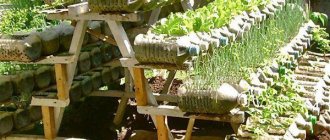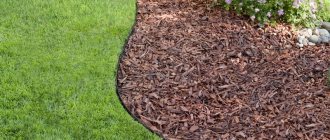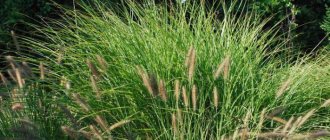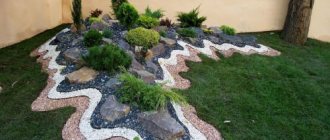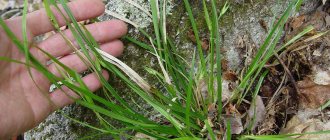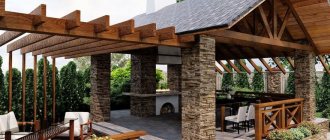Do-it-yourself mulch will help you preserve your flower garden at your dacha, and in some cases, improve it. For mulching, depending on the type of plant, sawdust, paper, straw, pine needles, bark, gravel, expanded clay and other materials are suitable.
Gardeners and gardeners successfully use mulch to protect many garden crops. It’s even more pleasant if the mulch is collected and made by yourself. But remember that it should not contain garbage, weed seeds and dangerous “chemicals”. Therefore, to mulch a flower garden, it is still better to use natural rather than artificial materials, no matter how beautiful they may seem to you.
The word “mulch” came to us from the English language. Mulching is the covering of the soil surface with natural or artificial materials to protect plants from weeds, moisture and frost. The substances and objects used for this are called mulch. Typically, mulch is shredded material, but sometimes an artificial surface or film, such as spunbond, is used for mulch.
Pine bark mulch
The bark of various trees can be used as mulch, but pine bark has gained particular popularity among experienced gardeners. It decomposes slowly and is suitable for any plant. It can be collected in coniferous or mixed forests, and can also be purchased at a garden store. It is easily separated from old trees and is also present on the ground. For perennial plants, a layer of 3-5 cm will be sufficient, for woody plants - 5-7 cm. Pine bark mulch, depending on the size of the particles, must be renewed every 2-3 years.
Make sure that the pine bark mulch is dry and does not clump together. Any mulch, one way or another, must provide access to water and air to the plant.
- Everything you need to know about mulch, its types and effects
Caution: not all types of mulch are created equal!
Advantages of decorative chips
- In addition to being soft, beneficial for the soil and decorative, tree bark is a natural eco-material and has many other advantages:
- decomposes and does not cause harm to humans or the environment;
- perfectly retains soil moisture and protects it from overheating;
- inhibits weed growth;
- decorates the landscape, including single plantings and floral compositions;
- serves for a long time (up to 5 years) and is not afraid of fungus;
- can be used as a covering for children's and sports grounds;
- allows you to create drawings on the ground in different styles and palettes;
- evokes associations with forest thickets due to its pleasant aroma;
- inexpensive.
Walnut shell mulch
Let's face it: this is one of the most expensive types of mulch, but if your family loves nuts, then why not get the maximum benefit from the nut along with the fruit? Moreover, the process of preparing this mulch is very simple: you just need to eat a lot of nuts and not throw away the shells. More precisely, throw it into the flower garden.
The shells of nuts such as walnuts, pine, pecans and hazelnuts are excellent for mulching perennials, as well as for woody plants. Roses and lilies feel great under such mulch. But remember that in tree and perennial plantings the layer of mulch should be different: 7-10 cm and 3-5 cm, respectively.
When changing mulch, it is recommended to remove the old material completely. It is especially important to update the mulch under plants that are prone to disease, such as roses.
Making decorative wood chips with your own hands
The easiest way to get decorative wood chips is to buy them in bags. You can also go to the nearest sawmill or wood products manufacturing facility. Next, the finished raw materials can be painted. If you wish, you can make wood chips yourself, but for this you will need a special machine designed for processing wood.
The resulting material is painted in small portions: the wood chips are poured into a bowl and filled with a mixture of dye diluted with a solvent to a liquid consistency. The contents of the bowl must be stirred constantly so that the material acquires an even color. After processing, it needs to be laid out to dry.
Peat mulch
Only high-moor peat is suitable for mulching - that which is formed in the uppermost layers of the soil. It consists of sphagnum moss, wild rosemary, cotton grass and other light herbs growing in swamps.
High peat can also be found in marshy areas. In order to extract it, you need to remove the top layer of soil with a shovel, and then “cut out” the required amount of peat with a sharper shovel, which must subsequently be dried at home. And since it is highly acidic, for the safe growth and development of plants in the flower garden it must be mixed with dolomite flour or lime (for 10 kg of high-moor peat add 1.5 kg of dolomite or 400-600 g of lime). For woody plants, the layer of such mulch should reach at least 7 cm, for other plants - 5-6 cm.
Inorganic materials
Inorganics are easy to use and retain their properties throughout the entire period of use. Also, such mulching does not change the properties of the substrate in any way.
For inorganic materials it is always better to use additional lining in the form of geotextiles , film , cardboard . This way the stones will not fall into the ground.
Film
The film can be made of agrofibre or polyethylene, which does not allow moisture to pass through. This is newer and more advanced material.
It is important to consider that slugs sometimes take root , especially if the season of high humidity begins. Fighting them under cover is much more difficult.
Before laying film or agrofibre, think through the irrigation system. This can be surface irrigation in open holes, or drip irrigation.
Interesting! You can lay decorative stones on top of the film, so the garden will look neater.
Pros:
- protects against rodents and pests;
- the dark coating retains heat, thereby warming the seedlings;
- there is no mold under the covering material;
- reduces moisture evaporation;
- due to such a barrier, the fruits do not fall to the ground and do not come into contact with pests;
- reduces humidity in enclosed spaces, for example, in greenhouses.
Agrofibre consists of polypropylene fibers, which are woven into a single fabric with slight perforation. Such material will definitely not allow any weed to pass through, despite this it perfectly allows the sun and water to pass through.
Important! Sometimes, due to the film, the air around the plants warms up too much. If plants are sensitive to elevated temperatures, this can be dangerous.
Berries , vegetables , and some fruits are covered with film . It can only be used once a year, i.e. By the beginning of next year, the film is replaced with a new one, because it loses its properties.
Expanded clay
Expanded clay is a good mulch, and at the same time it can act as a decorative decoration for the garden. However, there are a number of problems associated with the weight and properties of expanded clay.
The material is good for closed areas. In open ground, it is easily carried by the wind and washed away by water. Weeds also germinate, breaking through light stones.
dirt , dust , and soil easily stick to expanded clay . Seeds blown by the wind easily fall into such a substrate.
To avoid negative consequences, you need to:
- lay out a thick layer of expanded clay;
- avoid open areas with strong gusts of wind;
- give preference to closed soils.
Attention! If grass is cut near a cluster of expanded clay stones, you need to make sure that the stones remain in place. Otherwise, they will painfully bounce off the lawnmower right on your legs.
Gravel or pebble mulch
If you live near the sea or mountains, then you definitely won’t have problems obtaining this type of mulch. You can try to look for this material near rivers and lakes, but in this case you will be provided with a sand-gravel mixture. A gravel or pebble lawn has drainage properties and does not require special care. Depending on the size, gravel can be used for different plants.
Low perennials and alpine plants are mulched with fine gravel in a flower garden, spreading it in a layer of 2-3 cm. A small nuance of use is that such mulch has to be renewed annually. Coarse material covers the soil in which woody plants, shrubs and roses grow. The layer should be 5 cm thick. Pebble mulch is suitable for woody plants and shrubs and is also covered in a layer of approximately 5 cm.
The soil covered with mulch does not wash away during rains, even during heavy downpours.
How and when to do mulching correctly
There are no specific deadlines for this. The main mulching is usually carried out twice a year: in autumn and spring. There is nothing complicated about this; you can mulch the soil yourself, without involving outside specialists.
Autumn mulching is aimed at preserving the root system of plants from frost. Plus, if you use organic mulching, it will fertilize and saturate the soil before spring planting.
It is advisable to carry out spring mulching when the soil has already warmed up a little. Those. early spring is not the best time for mulching.
If you cover wet and cold soil, you can get a negative result in the form of rot and diseases of heat-loving plants. The optimal time for spring mulching is the end of May or the beginning of summer
However, regardless of whether you are doing autumn or summer mulching, there are general rules for preparing the soil before mulching that will allow you to achieve the desired result.
Before laying the layer, be sure to treat the area: remove weeds, roots and debris, loosen the soil well. Moisten the soil well, excluding row spacing. Apply fertilizer when mulching inorganically.
Mulch should be carefully placed on the site. Check the mulch from time to time, loosen and lift it, as it may cake. If its layer has become thin, then add more.
Freshly cut grass
Freshly cut grass mulch is suitable for many plants:
- peppers;
- tomatoes;
- strawberries;
- berry crops;
- eggplants, etc.
The main thing is to use mulching material correctly:
- Before use, be sure to dry the herb in the sun,
- lay mulch in a layer of at least 5 cm,
- As the old layers settle, do not forget to add new ones.
